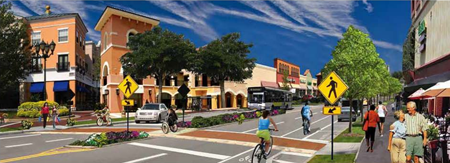
New Handbook Encourages Streamlined, Quantifiable
Bicycle and Pedestrian Plans
Federal transportation law and U.S. Department of Transportation (DOT) policy and guidance promote the planning and development of walking and bicycling networks as a key component of the transportation system. U.S. DOT policy encourages transportation agencies to go beyond the minimum requirements to provide safe and convenient facilities for these modes. This extra effort can result in numerous individual and community benefits in health, safety, environment, transportation, and quality of life.
To help State DOTs develop or update pedestrian and bicycle plans, the Federal Highway Administration (FHWA) has released the Statewide Pedestrian and Bicycle Planning Handbook. Developed from research, including interviews with nine State DOTs and a review of plans from 15 States, the handbook covers statewide planning from inception and scoping to implementation, including topics like engaging stakeholders and the general public; developing goals, objectives, and strategies; collecting and analyzing data; and linking to larger planning processes.
Opportunity to Improve Planning and Internal Processes
Research for the handbook revealed strong common threads in developing State pedestrian and bicycle plans across the country. The handbook highlights these shared themes, including plan focus, the planning process, institutional analysis, and performance management. One innovative concept that emerged through the research was the way in which plans are constructed. The document emphasizes the importance of organizing plans in a way that “works backwards,” beginning by identifying who will use the plan, how they will use it, and what it should accomplish, and then writing the plan accordingly.
Plan design can also streamline internal operations within a State DOT. The planning process is an opportunity to look inward and consider how to improve institutional relationships and statewide policies. Examining and improving internal coordination will help to focus the planning effort and more deeply engage stakeholders, which in turn can help to streamline planning and implementation of future projects. Designing a plan also provides an opportunity to review existing plans, programs, and policies to help identify adjustments that may need to be made to advance walking and bicycling in the State.

Pedestrian and bicycle plans yield individual and community benefits in health, safety, environment, transportation, and quality of life. (Courtesy of FHWA)
Case Studies Exemplify Strategic Decisionmaking Processes
The Statewide Pedestrian and Bicycle Planning Handbook showcases experiences and noteworthy practices from State DOTs around the country.
Keys to Success
Research, including interviews, for the handbook revealed a number of key success factors for statewide pedestrian and bicycle plans:
Promote clear and specific goals.
Engage staff and stakeholders to determine what actions are necessary to improve nonmotorized conditions and how the plan can prioritize them.
Improve internal integration and communication.
Use the plan’s development to engage all State DOT divisions and districts. This will build ownership, streamline planning, and improve efficiency, which will ultimately lead to more effectively implemented recommendations.
Strategically measure performance.
Use goals, objectives, and performance measures to make the plan transparent and clear in its purpose. Where possible, partner with existing data collection and performance tracking efforts.
Address the State Transportation Improvement Program, Long Range Transportation Plan, and SHSP.
The plan can explain the role and impact of these documents, how pedestrian and bicycle projects and policies relate to them, and recommend changes to the documents’ contents.
Invest in involving the public.
Involve the public in order to build support for the plan, understand the unique needs and concerns of pedestrians and bicyclists, and collect valuable data.
Consider the larger implications of State DOT facilities.
Keeping in mind local and regional plans, it is important to consider how State facilities support or hinder the connectivity and safety of existing or planned routes.
Louisiana
As vulnerable users of roadways, pedestrians and bicyclists are of primary importance to State DOTs. Ongoing statewide safety analyses and programs are important resources for planners in their statewide pedestrian and bicycle planning. Louisiana’s Department of Transportation and Development (LaDOTD) followed recommendations in their Strategic Highway Safety Plan (SHSP), a statewide, coordinated safety plan that provides a comprehensive framework for reducing highway injuries and fatalities on all public roads. The SHSP leverages limited resources by recommending that safety be a major component of all transportation investments. LaDOTD’s use of this resource precipitated the repositioning of the bicycle and pedestrian coordinator to their Safety Division.

State DOTs use performance measures to track progress and provide a framework for identifying strategies to meet their objectives. (Courtesy of NCDOT)
North Carolina
Connecting planning and performance measurement improves decisionmaking by linking plans to specific actionable strategies, and provides agency accountability for following through on the plan. The North Carolina Department of Transportation (NCDOT) oriented their plan around five goals and developed meaningful and relevant objectives, strategies, and performance measures to accompany each goal. Performance measures can be quantitative output (e.g., reduction in bicyclist injuries and fatalities) or qualitative outcome measures (e.g., milestones to achieve process objectives).
Colorado
To streamline their decisionmaking process, the Colorado Department of Transportation (CDOT) developed a project scoring tool. CDOT’s tool incorporates investment decision criteria to evaluate candidate pedestrian and bicycle projects. The tool evaluates projects alongside specific performance measures to aid project selection and, subsequently, make gains toward achieving statewide pedestrian and bicycle plan goals. CDOT developed criteria and refined them through a collaborative process involving a formal stakeholder group, the CDOT project team, and the public. After initial beta testing, CDOT refined the scoring criteria, added project readiness factors, and incorporated the scoring tool into funding decisions for the State’s Transportation Alternatives Program.
Handbook Emphasizes Efficient Planning
Plans that better accommodate walking and bicycling benefit all modes—by increasing mobility, reducing congestion, and improving safety. The Statewide Pedestrian and Bicycle Planning Handbook guides planners through coordinating comprehensive plans that produce specific, measurable community benefits. The planning process outlined in the document facilitates internal streamlining as well, calling upon existing documents, protocols, and practices to create an efficient work environment. It is designed to address practices and approaches specific to the context of the planning and programming responsibilities of State DOTs, but may also be useful for nonmotorized transportation planning on the local or regional scale.
Contact Information
Jody McCullough
Office of Planning
Federal Highway Administration
(202) 366-5001
Jody.McCullough@dot.gov
Michelle Noch
Office of Planning
Federal Highway Administration
(202) 366-9206
Michelle.Noch@dot.gov
Look What’s New!
- FHWA’s re:NEPA, Community of Practice Collaboration Site is back up and running. Re:NEPA is a discussion forum for environmental practitioners regarding environmental issues and questions including: the human environment, natural environment, NEPA process, Section 4(f), Section 106, air quality, etc. Click here to access the site.
- FHWA recently issued Order 5520, stating that it is FHWA policy to integrate consideration of climate and extreme weather risks into its planning, operations, policies and programs. To read FHWA Order 5520, click here.
Successes in Stewardship is a Federal Highway Administration newsletter highlighting current environmental
streamlining and stewardship practices from around the country. Click here to subscribe, or call (617) 494-3539 for more information.

